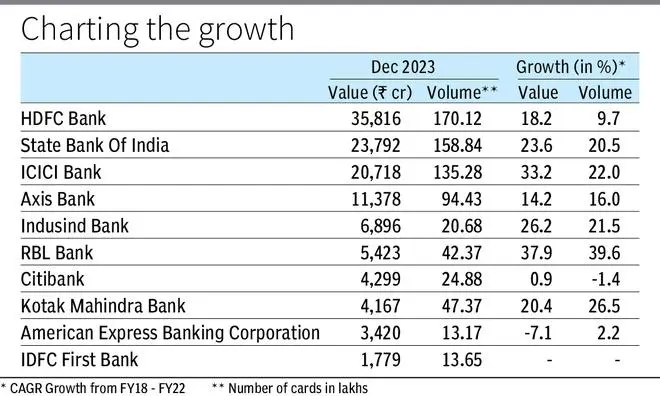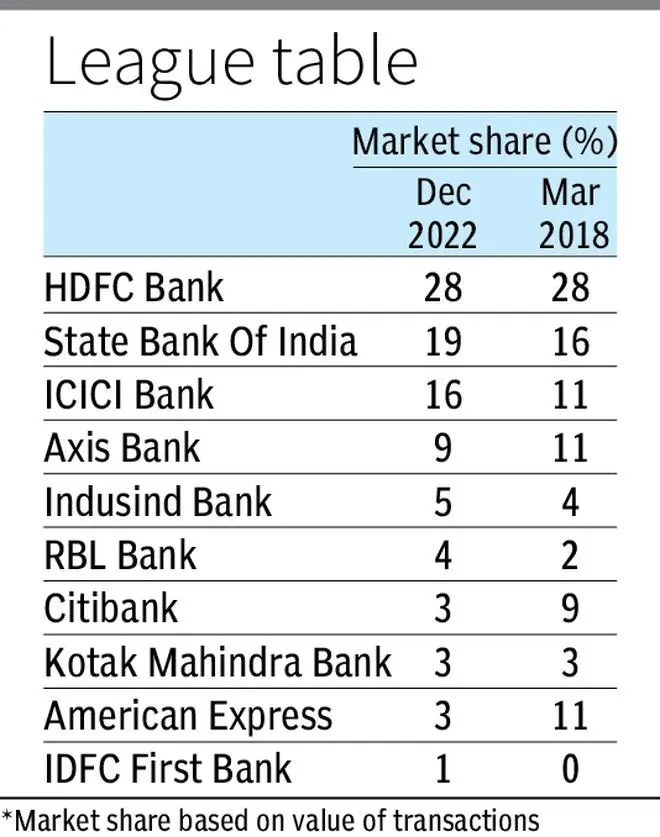Chirag is a Mumbai-based professional holding the credit cards of three large banks for several years. Yet, when it came to buying a fridge, he opted for an instant loan. Easy availability, longer repayment tenure, low processing fees and flexi-interest rates prompted him to go for a loan, instead of swiping a card.
Meenakshi is a new entrant to the employment world, and she isn’t a big fan of cards either. For her, credit cards are a big financial responsibility to handle. She funded her laptop through an over-the-counter loan from Bajaj Finserv.
People like Meenakshi and Chirag are already impacting the credit cards industry. Added to that is the rapid proliferation of buy now, pay later (BNPL) products across consumer segments, which have changed the way people use credit cards to shop, eat and travel.
While the outstanding consumer durable loans grew by 46 per cent year-on-year to ₹36,640 crore as of December 2022, credit card outstanding grew much slower at 27 per cent to ₹1.80-lakh crore.
But Shalini Warrier, Executive Director, Federal Bank, feels no threat to credits cards due to the advancement of products like BNPL. “India is a very underpenetrated credit card market. The ratio of debit cards is 10 times more than credit cards. So, there is still a lot of headroom to grow.”

She also added that unlike online-based BNPL products, credit cards have a physical form. This enables banks to build brand awareness and also helps consumers to connect with the banks for their subsequent product needs. Explaining how the segment is financially lucrative, Warrier adds that “margins and interchange fee are also attractive for banks. We believe that credit cards will continue to be an attractive business”.
Mayank Markanday, Head of Credit Card Business, AU Small Finance Bank — a relatively new entrant into the business — agrees with Warrier. Interestingly, he feels BNPL is an opportunity than a threat to cards. “By providing small credit lines to new-to-credit customers, BNPL will increase the credit penetration”.
Credit card usage
The bankers’ confidence is also reflecting on the numbers. Total outstanding credit cards grew by 17 per cent year-on-year to 8.12 crore cards as of December 2022, while spends on credit cards stood at ₹ 1.26-lakh crore, up 35 per cent year-on-year. Monthly credit card spends stayed over ₹ 1 trillion for the 10th month in a row in December 2022.
These numbers are despite the industry weathering the impact of multiple regulatory interventions; the recent one being the mandate in April last year asking card issuers to deactivate credit cards unused for more than a year.
For about 3-4 months starting July 2022, the move impacted all banks big and small. The outstanding number of credit cards of the country’s largest private sector lender HDFC Bank rose by a crawling 50 lakh (in volume) from March 2022 to December 2022. For Axis Bank, which is busy consummating its deal with Citibank, its standalone numbers fell by 3 lakh units to 94 lakhs cards in December 2022.

IDBI Capital is of the view that new credit card additions will trend downwards. “We continue to remain watchful of the net card additions, and expect the number to remain volatile for the next couple of months, led by players reporting as per the RBI guidelines.”
The volatility seems to have impacted the foreign players more as Citi and Amex (American Express), which earlier were the aspirational cards to flash and commanded a decent share in the pie, steadily losing the hold (see table).
Credit cards are turning to be the private banks’ fiefdom, with HDFC Bank, despite a near one-year ban on onboarding new customers, maintaining its market dominance with 28 per cent share. Several smaller banks, including IndusInd Bank and IDFC First Bank, have been quick to improve their presence, while RBL Bank, in spite of issues with its asset quality for most of FY20-22, remained focussed on cards business.
Market share
At present, the top five banks account for 77 per cent market share in the segment. With banks gearing for the next phase of growth, the question is whether cards will remain an upper-middle class product, or reach the masses enduring the fight from fintechs.
Anuj Kacker, co-founder of full-stack consumer neobanking platform, Freo, feels this is a threat banks shouldn’t ignore. “The proliferation of sustainable models around BNPL and other pay later products will be a threat to credit cards,” he emphasises, while adding that since there is a certain cost associated with credit cards, it may get stuck as larger segment product, missing the masses.
“The industry has only been focussing on the large, top-tier segment and ignoring the masses. If credit cards need to penetrate large masses, the only way is to sachetise the product with smaller credit limits,” Kacker explains.
Operating as a small finance bank, Markanday is attempting just this. He sees a big opportunity to increase credit card customers in Tier 2/3 markets and the self-employed segments. “With the advent of e-commerce and Internet, driving credit products has become easy across geographies and customer segments.” While the large private banks may remain busy with the urban masses to increase their engagements, banks like AU may play a pivotal role in popularising credit cards among the masses. How well this attempt succeeds will be known in 5-7 years.







Comments
Comments have to be in English, and in full sentences. They cannot be abusive or personal. Please abide by our community guidelines for posting your comments.
We have migrated to a new commenting platform. If you are already a registered user of TheHindu Businessline and logged in, you may continue to engage with our articles. If you do not have an account please register and login to post comments. Users can access their older comments by logging into their accounts on Vuukle.